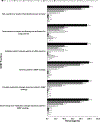Clinical Implementation of Self-Measured Blood Pressure Monitoring, 2015-2016
- PMID: 30337237
- PMCID: PMC6485411
- DOI: 10.1016/j.amepre.2018.06.017
Clinical Implementation of Self-Measured Blood Pressure Monitoring, 2015-2016
Abstract
Introduction: Self-measured blood pressure monitoring (SMBP) plus additional clinical support is an evidence-based strategy that improves blood pressure control. Despite national recommendations for SMBP use and potential cost savings, insurance coverage for implementation is limited in the U.S. and little is known regarding clinical implementation.
Methods: In 2017, using 2015 and 2016 DocStyles survey data from 1,590 primary care physicians and nurse practitioners in U.S. outpatient facilities, SMBP-related clinical practices and provider roles were assessed.
Results: Almost all (97%) respondents reported using SMBP. Among 1,539 who used SMBP, more than half (60%) used SMBP for a combination of diagnostic and treatment purposes, whereas 24% used SMBP for diagnosis only and 16% used SMBP for treatment only. The most common methods for patients to share SMBP results with clinical staff were paper log (68%); during appointments (66%); by telephone (37%); by secure website (22%); or by secure e-mail (19%). Nearly all (98%) respondents reported that medication adjustments were provided to patients based on SMBP readings. About 15% did not counsel patients regarding cuff size, and 8% did not validate patient devices. Only 13% of respondents reported having monitor loaner programs, and availability did not vary by the financial status of the patient population (p=0.59).
Conclusions: SMBP is used widely in outpatient facilities as reported in the survey, although provider roles and SMBP-related practices vary, and gaps exist regarding patient counseling, device validation, and loaner program availability. As part of efforts to improve hypertension control, healthcare professionals can promote increased use of best practices for SMBP, whereas insurers can implement standardization and support of SMBP.
Published by Elsevier Inc.
Figures
Similar articles
-
Accelerating Use of Self-measured Blood Pressure Monitoring (SMBP) Through Clinical-Community Care Models.J Community Health. 2021 Feb;46(1):127-138. doi: 10.1007/s10900-020-00858-0. J Community Health. 2021. PMID: 32564288 Free PMC article.
-
A Case Series Study Assessing an Equity-Focused Implementation of Self-Monitoring Blood Pressure Programs Using Telehealth.J Public Health Manag Pract. 2024 Jul-Aug 01;30:S71-S79. doi: 10.1097/PHH.0000000000001897. Epub 2024 Jun 12. J Public Health Manag Pract. 2024. PMID: 38870363 Free PMC article.
-
Return on investment of self-measured blood pressure is associated with its use in preventing false diagnoses, not monitoring hypertension.PLoS One. 2021 Jun 18;16(6):e0252701. doi: 10.1371/journal.pone.0252701. eCollection 2021. PLoS One. 2021. PMID: 34143817 Free PMC article.
-
Long-term Monitoring of Blood Pressure in Older Adults: A Focus on Self-Measured Blood Pressure Monitoring.Clin Geriatr Med. 2024 Nov;40(4):573-583. doi: 10.1016/j.cger.2024.04.009. Epub 2024 May 23. Clin Geriatr Med. 2024. PMID: 39349032 Review.
-
Evidence Brief: The Quality of Care Provided by Advanced Practice Nurses [Internet].Washington (DC): Department of Veterans Affairs (US); 2014 Sep. Washington (DC): Department of Veterans Affairs (US); 2014 Sep. PMID: 27606392 Free Books & Documents. Review.
Cited by
-
Prevalence, Treatment, Control and Monitoring of Hypertension: A Nationwide Community-Based Survey in Taiwan, 2017.Acta Cardiol Sin. 2020 Jul;36(4):375-381. doi: 10.6515/ACS.202007_36(4).20191220A. Acta Cardiol Sin. 2020. PMID: 32675930 Free PMC article.
-
Home Blood Pressure Monitoring in Cases of Clinical Uncertainty to Differentiate Appropriate Inaction From Therapeutic Inertia.Ann Fam Med. 2020 Jan;18(1):50-58. doi: 10.1370/afm.2491. Ann Fam Med. 2020. PMID: 31937533 Free PMC article.
-
Factors influencing implementation of a self-measured blood pressure program in community health centers: an implementation mapping approach.Front Public Health. 2025 Jul 17;13:1485343. doi: 10.3389/fpubh.2025.1485343. eCollection 2025. Front Public Health. 2025. PMID: 40746695 Free PMC article.
-
How Do We Jump-Start Self-measured Blood Pressure Monitoring in the United States? Addressing Barriers Beyond the Published Literature.Am J Hypertens. 2022 Mar 8;35(3):244-255. doi: 10.1093/ajh/hpab170. Am J Hypertens. 2022. PMID: 35259238 Free PMC article.
-
Physician perceived barriers and facilitators for self-measured blood pressure monitoring- a qualitative study.PLoS One. 2021 Aug 20;16(8):e0255578. doi: 10.1371/journal.pone.0255578. eCollection 2021. PLoS One. 2021. PMID: 34415946 Free PMC article.
References
-
- CDC. Vital Signs: Getting Blood Pressure Under Control www.cdc.gov/vitalsigns/hypertension. Published 2012. Accessed November 2, 2017.
-
- National Institute of Neurological Disorders and Stroke (NINDS), NIH. The Dementias: Hope through Research https://www.ninds.nih.gov/Disorders/Patient-Caregiver-Education/Hope-Thr.... Published 2013 Accessed November 2, 2017.
-
- Guide to Community Preventive Services. Cardiovascular disease prevention and control: self-measured blood pressure monitoring interventions for improved blood pressure control – when combined with additional support www.thecommunityguide.org/findings/cardiovascular-disease-self-measured-... Published 2015. Accessed November 2, 2017.
MeSH terms
Grants and funding
LinkOut - more resources
Full Text Sources
Medical
Research Materials


